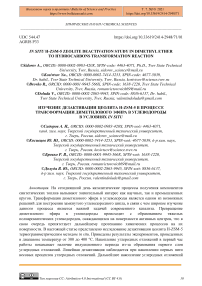In situ H-ZSM-5 zeolite deactivation study in dimethyl ether to hydrocarbons transformation reaction
Автор: Sidorov Aleksandr, Kosivtsov Yurii, Brovko Roman, Doluda Valentin
Журнал: Бюллетень науки и практики @bulletennauki
Рубрика: Химические науки
Статья в выпуске: 10 т.7, 2021 года.
Бесплатный доступ
Today, catalytic processes for the synthetic fuel components production are of considerable interest for both scientific and industrial area. The transformation of dimethyl ether into hydrocarbons is one of the possible solutions for the development of a closed hydrocarbon cycle, in connection with which a wide study of this process is an important task of modern catalysis. The transformation of dimethyl ether into hydrocarbons occurs with the formation of heavy polyaromatic hydrocarbons, which are deposited on the surface of active centers, which in turn prevents the further occurrence of chemical processes on their surface. This article presents a study of the deactivation of zeolite H-ZSM-5 by the thermogravimetric method in situ. The results of experiments carried out in the temperature range from to 300 to 400 °C are presented. The accumulation of carbon deposits in the first hour of operation indicates the presence of an induction period due to the formation of the first layer of carbon deposits. Linear decontamination occurs when the first five weight percent of carbon deposits accumulate. Further accumulation of carbon deposits up to eight weight percent leads to a sharp decrease in the rate of conversion of dimethyl ether into hydrocarbons to 0.08 kg (DME) / (kg (Cat) h). In the first hour of operation, aromatic hydrocarbons predominate in the reaction medium; with increasing time, the concentration of aromatic hydrocarbons decreases, and the concentration of light olefins and alkanes increases due to carbonization of the catalyst surface. The concentration of heavy aromatic hydrocarbons with a number of carbon atoms equal to or greater than eleven has a maximum after 240 minutes of reaction. The decrease in the content of heavy aromatic hydrocarbons after 240 minutes of reaction can be explained by the sharp loss of surface acidity due to carbonation.
Deactivation, dimethyl ether, zeolites, catalysts
Короткий адрес: https://sciup.org/14121399
IDR: 14121399 | УДК: 544.47 | DOI: 10.33619/2414-2948/71/01
Текст научной статьи In situ H-ZSM-5 zeolite deactivation study in dimethyl ether to hydrocarbons transformation reaction
Бюллетень науки и практики / Bulletin of Science and Practice
UDC 544.47
Wide application of catalytic technologies in fine and basic organic synthesis, in oil and fuel producing industries needs development of active and stable catalysts [1–3]. Therefore, sustainable techniques needs be developed to evaluate catalysts stability and activity especially in situ mode. Methanol to hydrocarbons catalytic transformation is widely applicable process for obtaining synthetic hydrocarbons including olefins, alkanes, and aromatic hydrocarbons [4–5]. This process can be easily used in carbon dioxide utilization cycle through carbon dioxide to methanol reaction followed by methanol to hydrocarbons transformation process. That it is why this process can be considered as a potentially green one. Commonly different zeolites and zeotypes are applied for this process depending on required hydrocarbons composition. Typically, H-ZSM-5 and SAPO-34 are used for aromatic hydrocarbons and olefins prevalent formation [6–7]. H-ZSM-5 was developed in the end of seventies of twenty century by Mobil corporation, USA and was firstly applied in synthetic fuel production in NewZealand. Zeolite H-ZSM-5 is characterized by complex internal structure formed by straight and sinusoidal channels with diameter 5.4–5.6Å, that results in huge microporosity enhancing aromatic hydrocarbons formation [8–9]. The rapid H-ZSM-5 zeolite deactivation by carbon depositions and matrix dealumination can be considered as the main disadvantage of its application. Great effort of scientific community was done to study H-ZSM-5 zeolite deactivation particularities, by different physicochemical methods generally ex situ [8–10]. For proper evaluation of H-ZSM-5 deactivation kinetics a data on carbon deposition weight growth needs to be collected in situ, without experiment stop. Therefore, this article is devoted to study of H-ZSM-5 zeolite deactivation kinetics in situ conditions.
Material and methods
The experiments were performed using thermogravimetric analyzer Netzsch 209 F1 Iris (Germany) Figure 1. For providing experiment 30 mg of H-ZSM-5 were placed in stainless steel crucible heated to 600 °C in 5 v.% of oxygen mixture in nitrogen at 1 bar overall pressure for one hour, than crucible was cooled to 300–400 °C and purged with nitrogen for one hour then with 5 v.% of dimethyl ether mixture in nitrogen for 3 hours, the sample mass measured every 5 seconds.
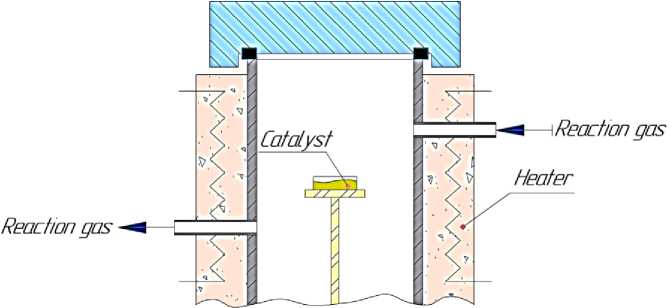
Figure 1. Scheme of thermogravimetric cell for catalysts stability test
Then sample was purged with nitrogen and 5 v.% of oxygen mixture in nitrogen and temperature was elevated up to 600 °C for two hours for zeolite regeneration. Thus, reaction and regeneration process were repeated several times to see catalysts activity loss during reaction and regeneration process.
Results and discussions
Obtained results on zeolite activity and carbon deposition correlation are presented on Figure 2a. Carbon deposition accumulation in the first hour on stream shows presence of induction period due to formation of first layer of carbon deposits. Linear deactivation takes place during accumulation of the first five weight per cents of carbon deposits that take place in the first three hours of reaction on stream. Further carbon deposits accumulation up to eight weight per cents results in drastic decrease of dimethyl ether to hydrocarbons transformation rate from 0.27 to 0.08 kg(DME)/(kg(Cat)h). Drastic change in hydrocarbon composition take place during dimethyl ether transformation reaction (Figure 2b). In the first hour on stream aromatic hydrocarbons predominate in reaction media, during increasing of time aromatic hydrocarbons concentration decrease while concentration of light olefins and alkanes increases due to carbonization of catalyst surface.
Concentration of alkanes and alkenes with carbon atoms quantity including and higher than six demonstrate peak profile at 120 minutes of reaction that can be explained by decrease of surface acidity because of carbonization. Concentration of heavy aromatic hydrocarbons with carbon atoms equal and higher than eleven shows peak profile with maximum at 240 minutes of reaction. Increasing of their concentration in the first reaction period can be subscribed to blockage with carbon deposits and decreasing of reagent diffusivity. Decreasing of heavy aromatics hydrocarbons after 240 minutes on stream can be explained by drastic surface acidity loss due to surface carbonization and inability of heavy hydrocarbons formation.
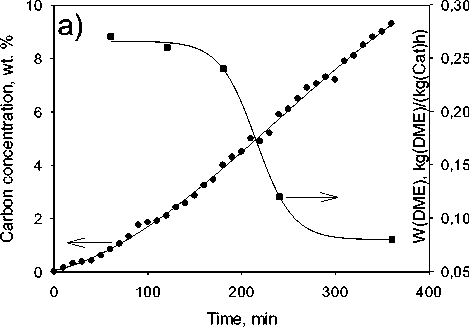
Figure 2. Correlation of carbon deposition concentration on time with dimethyl ether transformation

Time, min
rate on time (reaction temperature 350 °C, dimethyl ether (DME) feed rate 0.3 kg (DME)/(kg(Cat)*h))
Study of temperature influence over catalyst deactivation rate are shown on Figure 3. Increasing of reaction temperature from 300 °C up to 400 °C result in appropriate increase of surface carbonization rate. Methanol transformation rate remains stable for 200 minutes on stream at 300°C, increasing of reaction temperature up to 350 °C results in decrease of stable work time down to 180 minutes, further increasing of reaction temperature up to 400 °C results in decrease of stable work time down to 60 minutes on steam. However, the reaction rate stabilizes, and access to the new shell in two-tree folds is lower compared to initial reaction rates.
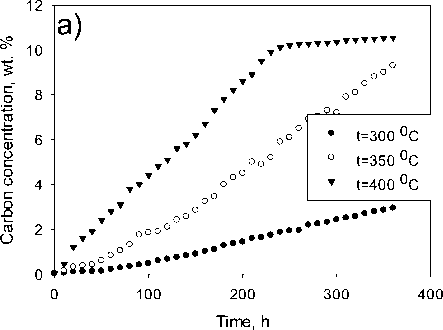
Figure 3. Correlation of a) carbon deposition concentration b) reaction rate on time with dimethyl ether transformation rate on time (reaction temperature 300-400 °C, dimethyl ether (DME) feed rate 0.3 kg(DME)/(kg(Cat)*h))
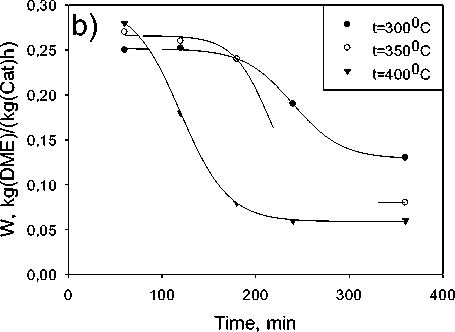
After reaction deactivated catalyst was recovered using oxidative treatment. For this catalyst sample was heated up to 600°C in 5 v.% of oxygen mixture in nitrogen at 1 bar overall pressure for one hour, than crucible was cooled to and reaction was started again. Initial activity of catalysts after first regeneration was found to be 0.23 kg(DME)/(kg(Cat)*h)) while after second regeneration initial activity decreased down to be 0.23 kg(DME)/(kg(Cat)*h)). Obtained results are shown in figure 4, from where only partition recovery of initial activity is easily seen. Partial catalytic activity loss after catalysts regeneration can be attributed to active sites leaching because of aluminum hydrolysis during reaction. For regenerated samples activity loss take place gradually without drastic decrease that can be attributed to lower initial surface concentration of active sites. Decrease of initial catalysts activity is seen after each regeneration that reflects possible partial decrease of active sites surface concentration.
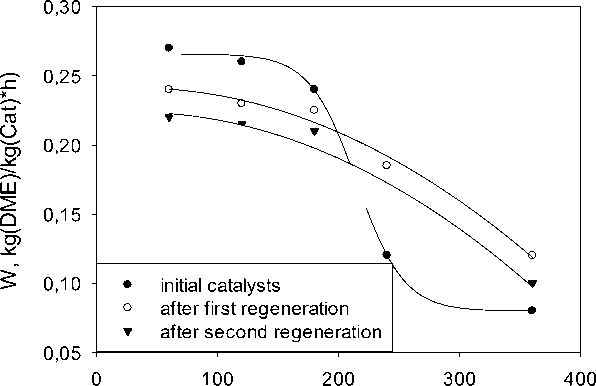
Time, min
Figure 4. Correlation of reaction rate for recovered sample (reaction temperature 350 °C, dimethyl ether (DME) feed rate 0.3 kg(DME)/(kg(Cat)*h))
Conclusions
In situ study of dimethyl ether to hydrocarbons transformation shows considerable decrease of initial activity due to partial pores blockage with carbon deposits. Linear deactivation takes place during accumulation of the first five weight per cents of carbon deposits that take place in the first three hours of reaction on stream. Further carbon deposits accumulation up to eight weight per cents results in drastic decrease of dimethyl ether to hydrocarbons transformation rate from 0.27 to 0.08 kg(DME)/(kg(Cat)h). Used catalyst can be calcined for partial activity recovery. For regenerated samples activity loss take place gradually without drastic decrease that can be attributed to lower initial surface concentration of active sites. Decrease of initial catalysts activity is seen after each regeneration that reflects possible partial decrease of active sites surface concentration.
The study was funded by Russian foundation for basic research project number 20-08-00433 А.
Список литературы In situ H-ZSM-5 zeolite deactivation study in dimethyl ether to hydrocarbons transformation reaction
- Zhang J., Xu L., Zhang Y., Huang Z., Zhang X., Zhang X., Xu L. et al. Hydrogen transfer versus olefins methylation: On the formation trend of propene in the methanol-to-hydrocarbons reaction over Beta zeolites // Journal of Catalysis. 2018. V. 368. P. 248-260. DOI: 10.1016/j.jcat.2018.10.015
- Долуда В. Ю., Сульман М. Г., Матвеева В. Г., Лакина Н. В., Быков А. В., Сульман Э. М. Каталитическая трансформация метанола в углеводороды // Вестник Тверского государственного университета. Серия: Химия. 2015. №4. С. 60-66.
- Chotiwan S., Somwongsa P., Lao-ubol S., Lao-auyporn P., Attanatho L., Laosombut T., Larpkiattaworn S. Two-step catalytic hydrogenation of methanol to hydrocarbons conversion // Materials Today: Proceedings. 2019. V. 17. P. 1362-1369. DOI: 10.1016/j.matpr.2019.06.156
- Arora S. S., Bhan A. The critical role of methanol pressure in controlling its transfer dehydrogenation and the corresponding effect on propylene-to-ethylene ratio during methanol-to-hydrocarbons catalysis on H-ZSM-5 // Journal of Catalysis. 2017. V. 356. P. 300-306. DOI: 10.1016/j.jcat.2017.10.014
- Долуда В. Ю., Лакина Н. В., Бровко Р. В. Каталитическая трансформация диметилового эфира в углеводороды на железо модифицированном цеолите H-ZSM-5 // Бюллетень науки и практики. 2019. Т. 5. №12. С. 12-19. DOI: 10.33619/2414-2948/49/01
- Lee S., Choi M. Unveiling coke formation mechanism in MFI zeolites during methanol-to-hydrocarbons conversion // Journal of catalysis. 2019. V. 375. P. 183-192. DOI: 10.1016/j.jcat.2019.05.030
- Zhang Z., Liu B., Liu F., Zhao Y., Xiao T. Effect of nickel loading on the performance of nano-and micro-sized ZSM-5 catalysts for methanol to hydrocarbon conversion // Catalysis Today. 2018. V. 317. P. 21-28. DOI: 10.1016/j.cattod.2018.03.044
- Li L., Gu L., Jin C., Fei, P. Synthesis of SiGeAl-ITQ-13 and SiAl(B)-ITQ-13 and their catalytic performance in the conversion of methanol to hydrocarbons // Journal of Fuel Chemistry and Technology. 2017. V. 45. №10. P. 1244-1250. DOI: 10.1016/s1872-5813(17)30056-7
- Grahn M., Faisal A., Öhrman O. G., Zhou M., Signorile M., Crocellà V., Hedlund J. Small ZSM-5 crystals with low defect density as an effective catalyst for conversion of methanol to hydrocarbons // Catalysis Today. 2020. V. 345. P. 136-146. DOI: 10.1016/j.cattod.2019.09.023
- Kim S., Park G., Kim S. K., Kim Y. T., Jun K. W., Kwak G. Gd/HZSM-5 catalyst for conversion of methanol to hydrocarbons: effects of amounts of the Gd loading and catalyst preparation method // Applied Catalysis B: Environmental. 2018. V. 220. P. 191-201. DOI: 10.1016/j.apcatb.2017.08.056

